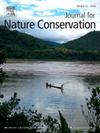IF 2.2
3区 环境科学与生态学
Q2 BIODIVERSITY CONSERVATION
引用次数: 0
摘要
热带湿润森林生态系统是高碳储量的重要储存库,同时也具有丰富的生物多样性。这些生态系统中的保护区增加了本地花卉和动物群落的数量,保护了生物多样性。本研究旨在利用多光谱和合成孔径雷达遥感技术(哨兵-1、哨兵-2、LISS-IV)以及集合机器学习模型,对印度东北部特里普拉邦的罗瓦野生动物保护区(RWLS)的地上生物量存量和树木多样性进行定量基线测绘。我们建立了 126 个地块(10 m × 10 m),对树木、草本植物、灌木、枯木和落叶进行实地采样。我们使用局部异速模型来计算实地树木的 AGB。我们还估算了与生物多样性有关的不同指数,如重要价值指数、科重要价值、皮鲁均匀度指数、马加莱夫丰富度指数、辛普森优势指数和香农-维纳多样性指数。结果显示,该地区有 68 个树种,物种丰富度中等偏上。树木密度为 1412 株/公顷,明显高于通常水平,而平均基部面积为 20.11 平方米/公顷,则偏低。这些结果表明,森林以直径较小的树木为主,可能表明这是一片正在恢复的次生林,经常受到干扰。遥感分析表明,尽管 LISS-IV 的空间分辨率更高,但哨兵-2 在预测 AGB 方面的表现优于 LISS-IV,这突出表明了光谱分辨率在估算生物量方面的重要性。纳入生物多样性指数(香农-维纳指数、辛普森指数和 Margalef 指数)也显著提高了 AGB 估计值(R2 = 0.59)。据估计,RWLS 的平均 AGB 为 122.60 ± 42.75 兆克公顷-1。本研究还观察到,通过高辛普森指数(D = 0.18)和低均匀度(0.6)反映出,Microcos paniculata 这一物种占优势,这表明它是在该地区过去受到干扰后定植的。考虑到在人类活动的压力下,RWLS 作为一个小型保护区所面临的挑战,研究结果强调了在 RWLS 开展有针对性的保护工作的必要性。我们建议实施造林处理,采取措施防止干扰,并利用先进的遥感技术建立反复监测制度。本文章由计算机程序翻译,如有差异,请以英文原文为准。
Estimating aboveground biomass and biodiversity of a protected area in moist tropical forest ecosystem using remote sensing application
Moist tropical forest ecosystems serve as substantial repositories for high carbon stocks and are also rich in biodiversity. Protected areas in these ecosystems increase the population of native floral and faunal communities and conserve biodiversity. This study aimed to provide a quantitative baseline mapping of aboveground biomass stock and tree diversity in the Rowa Wildlife Sanctuary (RWLS) of Tripura, northeast India using multispectral and SAR remote sensing (Sentinel-1, Sentinel-2, LISS-IV) and ensemble machine learning models. We established 126 plots (10 m × 10 m) for field sampling of trees, herbs, shrubs, deadwood, and leaf litter. Local allometric models were used to calculate tree-level AGB in the field. We also estimated different indices pertaining to biodiversity such as the Importance Value Index, Family Importance Value, Pielou’s Evenness index, Margalef’s richness index, Simpson’s Dominance index and Shannon-Wiener Diversity Index. Our results showed 68 tree species in the area, indicating moderately high species richness. The tree density of 1412 trees ha−1 was significantly higher than usual, while the mean basal area of 20.11 m2/ha was low. These findings suggest a forest dominated by smaller diameter trees, potentially indicating a recovering secondary forest subject to frequent disturbances. Remote sensing analysis demonstrated that Sentinel-2 outperformed LISS-IV in predicting AGB, despite LISS-IV’s higher spatial resolution, highlighting the importance of spectral resolution in estimating biomass. Incorporating biodiversity indices (Shannon-Wiener, Simpson’s, and Margalef’s) also significantly improved AGB estimates (R2 = 0.59). The mean AGB of RWLS was estimated as 122.60 ± 42.75 Mg ha−1. The present study also observed a dominance of the species Microcos paniculata, reflected through high Simpson index (D = 0.18) and low evenness (0.6), which suggests its colonization after past disturbances in the area. The outcomes of the study underscore the need for targeted conservation efforts in RWLS, considering its challenges as a small protected area under anthropogenic pressure. We recommend implementing silvicultural treatments, measures to prevent disturbances, and establishing a regime of repeated monitoring using advanced remote sensing technologies.
求助全文
通过发布文献求助,成功后即可免费获取论文全文。
去求助
来源期刊

Journal for Nature Conservation
环境科学-生态学
CiteScore
3.70
自引率
5.00%
发文量
151
审稿时长
7.9 weeks
期刊介绍:
The Journal for Nature Conservation addresses concepts, methods and techniques for nature conservation. This international and interdisciplinary journal encourages collaboration between scientists and practitioners, including the integration of biodiversity issues with social and economic concepts. Therefore, conceptual, technical and methodological papers, as well as reviews, research papers, and short communications are welcomed from a wide range of disciplines, including theoretical ecology, landscape ecology, restoration ecology, ecological modelling, and others, provided that there is a clear connection and immediate relevance to nature conservation.
Manuscripts without any immediate conservation context, such as inventories, distribution modelling, genetic studies, animal behaviour, plant physiology, will not be considered for this journal; though such data may be useful for conservationists and managers in the future, this is outside of the current scope of the journal.
 求助内容:
求助内容: 应助结果提醒方式:
应助结果提醒方式:


